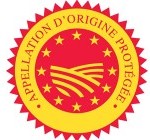AOC (Appellation d’Origine Contrôlée) since 1991, Epoisses received the AOP label (Appellation d’Origine Protégée in French/Protected Designation of Origin (PDO) in English). in 1996 and enjoys protection throughout the whole of Europe.
It is a washed rind soft cheese, produced using full-fat cows’ milk.
An AOP classification is based on three main criteria, in a defined geographical zone and monitored by an independent organisation:
– The origin of the milk: the milk producers must be identified. They must respect strict rules concerning the hygiene and the feeding of their cows, which must belong to one of the three following races: Simmental, Brune des Alpes and Montbéliarde.

 – Respect for the age-old cheese making tradition: every cheese maker must respect precise specifications concerning the production of the cheeses, and each stage of the process is rigorously monitored.
– Respect for the age-old cheese making tradition: every cheese maker must respect precise specifications concerning the production of the cheeses, and each stage of the process is rigorously monitored.
– The quality of the cheeses:
Visually the rind is shiny, smooth or slightly wrinkled. The colour of the Epoisses rind can vary between ivory with orange hints and brick red.
This red colour on the rind is caused solely by the bacteria that develop on the surface (Brevibacterium linens) as a result of the successive washes. The use of colourants is forbidden.
Epoisses cheese is pale beige in colour, with a creamy and melting texture.
Epoisses is presented in a cylindrical shape with flat, parallel faces, and a surface that is straight or slightly bulging.
It can be found in two different formats:
– Between 95 and 115 millimetres in diameter, 30 to 45 millimetres in height for a weight between 250 and 350 grams
– Between 165 and 190 millimetres in diameter, 30 to 45 millimetres in height for a weight between 700 and 1100 grams
The milk used, the cheese making process and the maturation of Epoisses cheese must be sourced /undertaken in the zone defined by the decree of 1991 covering part of the Côte-d’Or department and a few districts of the Haute Marne and the Yonne departments.


